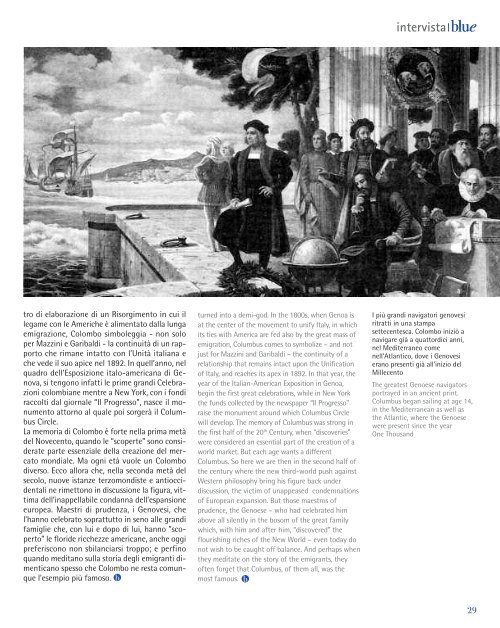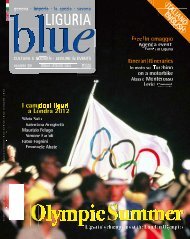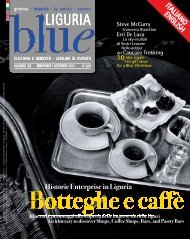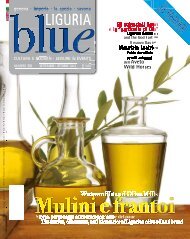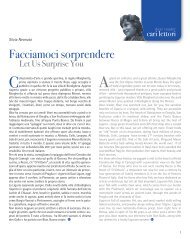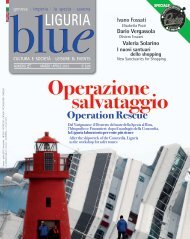Download PDF - Blue Liguria - Sagep
Download PDF - Blue Liguria - Sagep
Download PDF - Blue Liguria - Sagep
You also want an ePaper? Increase the reach of your titles
YUMPU automatically turns print PDFs into web optimized ePapers that Google loves.
intervista<br />
blue<br />
tro di elaborazione di un Risorgimento in cui il<br />
legame con le Americhe è alimentato dalla lunga<br />
emigrazione, Colombo simboleggia - non solo<br />
per Mazzini e Garibaldi - la continuità di un rapporto<br />
che rimane intatto con l’Unità italiana e<br />
che vede il suo apice nel 1892. In quell’anno, nel<br />
quadro dell’Esposizione italo-americana di Genova,<br />
si tengono infatti le prime grandi Celebrazioni<br />
colombiane mentre a New York, con i fondi<br />
raccolti dal giornale “Il Progresso”, nasce il monumento<br />
attorno al quale poi sorgerà il Columbus<br />
Circle.<br />
La memoria di Colombo è forte nella prima metà<br />
del Novecento, quando le “scoperte” sono considerate<br />
parte essenziale della creazione del mercato<br />
mondiale. Ma ogni età vuole un Colombo<br />
diverso. Ecco allora che, nella seconda metà del<br />
secolo, nuove istanze terzomondiste e antioccidentali<br />
ne rimettono in discussione la figura, vittima<br />
dell’inappellabile condanna dell’espansione<br />
europea. Maestri di prudenza, i Genovesi, che<br />
l’hanno celebrato soprattutto in seno alle grandi<br />
famiglie che, con lui e dopo di lui, hanno ”scoperto”<br />
le floride ricchezze americane, anche oggi<br />
preferiscono non sbilanciarsi troppo; e perfino<br />
quando meditano sulla storia degli emigranti dimenticano<br />
spesso che Colombo ne resta comunque<br />
l’esempio più famoso.<br />
turned into a demi-god. In the 1800s, when Genoa is<br />
at the center of the movement to unify Italy, in which<br />
its ties with America are fed also by the great mass of<br />
emigration, Columbus comes to symbolize – and not<br />
just for Mazzini and Garibaldi – the continuity of a<br />
relationship that remains intact upon the Unification<br />
of Italy, and reaches its apex in 1892. In that year, the<br />
year of the Italian-American Exposition in Genoa,<br />
begin the first great celebrations, while in New York<br />
the funds collected by the newspaper “Il Progresso”<br />
raise the monument around which Columbus Circle<br />
will develop. The memory of Columbus was strong in<br />
the first half of the 20 th Century, when “discoveries”<br />
were considered an essential part of the creation of a<br />
world market. But each age wants a different<br />
Columbus. So here we are then in the second half of<br />
the century where the new third-world push against<br />
Western philosophy bring his figure back under<br />
discussion, the victim of unappeased condemnations<br />
of European expansion. But those maestros of<br />
prudence, the Genoese – who had celebrated him<br />
above all silently in the bosom of the great family<br />
which, with him and after him, “discovered” the<br />
flourishing riches of the New World – even today do<br />
not wish to be caught off balance. And perhaps when<br />
they meditate on the story of the emigrants, they<br />
often forget that Columbus, of them all, was the<br />
most famous.<br />
I più grandi navigatori genovesi<br />
ritratti in una stampa<br />
settecentesca. Colombo iniziò a<br />
navigare già a quattordici anni,<br />
nel Mediterraneo come<br />
nell’Atlantico, dove i Genovesi<br />
erano presenti già all’inizio del<br />
Millecento<br />
The greatest Genoese navigators<br />
portrayed in an ancient print.<br />
Columbus began sailing at age 14,<br />
in the Mediterranean as well as<br />
the Atlantic, where the Genoese<br />
were present since the year<br />
One Thousand<br />
29


